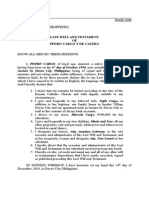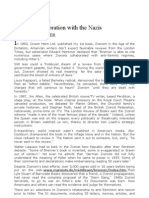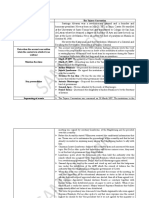Riph - Activity 2
Riph - Activity 2
Uploaded by
SHEANNE DOBLUISCopyright:
Available Formats
Riph - Activity 2
Riph - Activity 2
Uploaded by
SHEANNE DOBLUISOriginal Title
Copyright
Available Formats
Share this document
Did you find this document useful?
Is this content inappropriate?
Copyright:
Available Formats
Riph - Activity 2
Riph - Activity 2
Uploaded by
SHEANNE DOBLUISCopyright:
Available Formats
Activity # 2
1. Who is Santiago Alvarez? How come his writing is a primary source?
General of the Revolution Santiago Alvarez, better known as "Kidlat ng Apoy," founded and
served as honorary president of the Naciolista Party's first directorship. Because of his devotion
and bravery while leading the battles in Cavite, he became known as Kidlat ng Apoy. He is also
Mariano Alvarez's lone kid. He wrote "Katipunan and the Revolution: Memoirs of a General,"
which is regarded as a main source due to the fact that it was written or developed during the
Tejeros Convention and serves as an eyewitness narrative.
2. Who is Teodoro Agoncillo? How come his writing is a secondary source?
Teodoro Agoncillo is a well-known Filipino historian from the 20th century. Teodoro and Renato
Constantino, two historians who lived in the same era as him, are credited with being the first
Filipinos to advocate for an uniquely nationalist interpretation of Philippine history. He wrote
"The Revolt of the Masses, the narrative of Bonifacio and the Katipunan," which is classified as a
secondary source because the author only interprets and evaluates the primary materials, which
concern what transpired during the Tejeros Convention.
3. Create a chart comparing in detail the accounts of the two writers regarding the “Tejeros
Convention”
"The Revolt of the Masses, the story of
"Katipunan and the Revolution: Memoirs of
Bonifacio and the Katipunan" by Teodoro
a General" by Santiago Alvarez.
Agoncillo.”
(PRIMARY SOURCE)
(SECONDARY SOURCE)
As a member of the Magdiwang group and a The writing of Teodoro Agoncillo is not based
conference attendee, Santiago Alvarez was on his own experiences, but rather on an
able to observe all that transpired at the account from other sources.
Tejeros Convention.
Includes quotes from conversations that took There are fewer discussions in his writing.
place throughout the convention.
His work is more concerned with what In his writing, he employs figures of speech.
transpired or how the election went at
Tejeros Convention.
Enumerates the six available positions for the His writings are particularly preoccupied with
elections of the officials. what occurred before the Tejeros
Convention.
In his writings, the class conflict is also He documents significant events like the
depicted, such as when Daniel Tirona chose battle that took place just before the Tejeros
Mr. Jose Del Rosario over Bonifacio to serve Convention began.
as Secretary of the Interior because Tirona
thought Del Rosario was better qualified
because Bonifacio lacked any credentials.
It was written in the year of 1927. His writings are intended to educate the
young people of his generation about the
revolution's history and revolutionary
struggles.
Includes what happened after the election. It was written in October 1947 until January
1948.
He emphasized Bonifacio's emotion.
He ended his work with the election of
officials that happened in the Tejeros
Convention.
4. Form your internal and external criticisms over the two sources.
"Katipunan and the Revolution: Memoirs of a General" by Santiago Alvarez.
Internal Criticism: Santiago Alvarez's writing is very trustworthy; it explains in detail what took
place during the Tejeros Convention, which was a betrayal, and their plans to harm the Spanish
people. However, Santiago Alvarez's work is more concerned with the election and what
transpired during it.
External Criticism: Santiago Alvarez also has a distinctive style of writing, and everything he says
in his works is the absolute truth because he lived through the events they are based on and
wrote them. He writes objectively about the propertied class's betrayal, the ascent of a peasant
leader, and the popular uprising against Spain. His writing is devoid of adjectives and comprises
quotes from convention dialogues. He was unable to capture the true sentiment of the Tejeros
Convention participants.
"The Revolt of the Masses, the story of Bonifacio and the Katipunan" by Teodoro Agoncillo.
Internal Criticism: He demonstrates in his writings that the armed independence movement in
Manila was started by workers and craftspeople, and that the upper classes were only
grudgingly dragged into the conflict. Even though it's only a secondary source, he did a fantastic
job of writing his work.
External Criticism: Teodoro Agoncillo writes about the Tejeros Convention in a distinctive
manner, and his works also address revolution, nationalism, class conflict, and the conflict that
took place before the Tejeros Convention. In his writing, he accentuated Bonifacio's emotion
and employed figures of phrase. Less conversation may be found in his writing.
You might also like
- Gregoria de Bonifacio, "Kasulatan" Sent To Emilio Jacinto, C. June 1897Document30 pagesGregoria de Bonifacio, "Kasulatan" Sent To Emilio Jacinto, C. June 1897Kilrone Etulle100% (3)
- Trust Agreement: (NAME OF MINOR), Filipino, With Residence at (ADDRESS), HereinDocument3 pagesTrust Agreement: (NAME OF MINOR), Filipino, With Residence at (ADDRESS), HereinKvyn HonoridezNo ratings yet
- EXCERPT FROM THE SANTIAGO ALVAREZ ACCOUNT "Katipunan and The Revolution: Memoirs of A GeneralDocument5 pagesEXCERPT FROM THE SANTIAGO ALVAREZ ACCOUNT "Katipunan and The Revolution: Memoirs of A Generalchu pikachu43% (7)
- Santiago Alvarez's Katipunan and The Revolution Memoirs of A General and Teodoro Agoncillo's History of The Filipino PeopleDocument3 pagesSantiago Alvarez's Katipunan and The Revolution Memoirs of A General and Teodoro Agoncillo's History of The Filipino PeopleNinna PeñaNo ratings yet
- Readings in Philippine History - Activity 2: Test of Authenticity and CredibilityDocument4 pagesReadings in Philippine History - Activity 2: Test of Authenticity and CredibilityLOMIBAO, Raneniel S.100% (2)
- Riph ActivityDocument4 pagesRiph ActivityMa. Ruffa Mae Mejia100% (1)
- Readings in The Philippine History: Tests of Authenticity and Credibility: The Tejeros Convention of 1897Document8 pagesReadings in The Philippine History: Tests of Authenticity and Credibility: The Tejeros Convention of 1897John Alexis CabolisNo ratings yet
- Last Will and Testament of Pedro Cargo (Practice Court)Document3 pagesLast Will and Testament of Pedro Cargo (Practice Court)Aia Tmnda100% (2)
- Lenni Brenner 51 Documents Zionist Collaboration With The NazisDocument4 pagesLenni Brenner 51 Documents Zionist Collaboration With The NazisChew Kok100% (1)
- Activity RIPH Princess Jovelyn GutierrezDocument2 pagesActivity RIPH Princess Jovelyn GutierrezPrincess Jovelyn GutierrezNo ratings yet
- Activity 2Document7 pagesActivity 2Shaneen AdorableNo ratings yet
- A Written Report in Tejeros ConventionDocument2 pagesA Written Report in Tejeros ConventiondanaecagraceNo ratings yet
- Test of AuthenticityDocument6 pagesTest of AuthenticityCaila GuerreroNo ratings yet
- Comparative Analysis of Historical Accounts About The Tejeros ConventionDocument2 pagesComparative Analysis of Historical Accounts About The Tejeros Conventiongabrielle annNo ratings yet
- Riph 111 Act 2 de GuzmanDocument2 pagesRiph 111 Act 2 de Guzmanbianca dgNo ratings yet
- Template Assessment 3Document15 pagesTemplate Assessment 3Mqnggp NciwgtvcNo ratings yet
- Activity 2Document4 pagesActivity 2Sherie Anne BernabeNo ratings yet
- Activity 2Document2 pagesActivity 2Muyano, Louis Anthony0% (1)
- Santiago Alvarez's Account On The Tejeros Assembly: Xyza Domingo-Ron Alec AlejandroDocument2 pagesSantiago Alvarez's Account On The Tejeros Assembly: Xyza Domingo-Ron Alec AlejandroXyza DomingoNo ratings yet
- Areas of Analytical Comparison "Katipunan and The Revolution" "History of The Filipino People"Document5 pagesAreas of Analytical Comparison "Katipunan and The Revolution" "History of The Filipino People"Mark Ryan LiwanagNo ratings yet
- Tejeros ConventionDocument2 pagesTejeros ConventionThrish Rañada TanierlaNo ratings yet
- 2Document6 pages2Rizalito SisonNo ratings yet
- Santiago Alvarez Also Known AsDocument2 pagesSantiago Alvarez Also Known AsAnamae100% (1)
- Who Is Santiago Alvarez? How Come His Writing Is A Primary Source?Document4 pagesWho Is Santiago Alvarez? How Come His Writing Is A Primary Source?yani yaniNo ratings yet
- Riph Assessment Task 2Document4 pagesRiph Assessment Task 2Kia GraceNo ratings yet
- Compare and ContrastDocument5 pagesCompare and ContrastAdrian GarciaNo ratings yet
- Hermoso TaboncaveDocument5 pagesHermoso TaboncaveweeweeNo ratings yet
- The Anarchist Expropriators: Buenaventura Durruti and Argentina's Working-Class Robin HoodsFrom EverandThe Anarchist Expropriators: Buenaventura Durruti and Argentina's Working-Class Robin HoodsNo ratings yet
- Riph Book 35 38Document5 pagesRiph Book 35 38Gilbert BantaNo ratings yet
- Readings in Philippine History - Book ReviewDocument7 pagesReadings in Philippine History - Book Reviewmichaellapascua05No ratings yet
- Reading in Philippine History - Activity 1Document2 pagesReading in Philippine History - Activity 1James DarylNo ratings yet
- Module I: Thinking Like A Historian - Worksheet For Primary Sources On The Tejeros ConventionDocument2 pagesModule I: Thinking Like A Historian - Worksheet For Primary Sources On The Tejeros ConventionMaui TimbalNo ratings yet
- Activity #2 RiphDocument3 pagesActivity #2 RiphDanielle LosanesNo ratings yet
- Paredes - Unit 1 Activity 3Document4 pagesParedes - Unit 1 Activity 3Cleo TrinidadNo ratings yet
- Compare and Contrast The Work of Santiago Alvarez and Teodoro AgoncilloDocument2 pagesCompare and Contrast The Work of Santiago Alvarez and Teodoro AgoncilloJamila Therese Enicuela Barlizo100% (1)
- RIPHDocument7 pagesRIPH20-SURATOS, RHAEDEN ANNENo ratings yet
- Libarnes JP GED-103 FOPM02 1Q2122 CO1Document1 pageLibarnes JP GED-103 FOPM02 1Q2122 CO1Jep LibarnesNo ratings yet
- Critiquing SampleDocument4 pagesCritiquing SampleRu JahmaNo ratings yet
- Activity #1Document3 pagesActivity #1Jafet LlaneraNo ratings yet
- KKKDocument4 pagesKKKCherry Ann LumpasNo ratings yet
- Reading in Philippine History GallonDocument2 pagesReading in Philippine History GallonBen Matthew Alferez CoNo ratings yet
- Arcilla, Jose S. "Who Is Andres Bonifacio?" Philippine Studies 45 (Fourth Quarter 1997) : 570-5Document8 pagesArcilla, Jose S. "Who Is Andres Bonifacio?" Philippine Studies 45 (Fourth Quarter 1997) : 570-5Yoona LIMNo ratings yet
- Katipunan and The Revolution AssDocument3 pagesKatipunan and The Revolution AssSchool Desk SpaceNo ratings yet
- The Tejeros ConventionDocument2 pagesThe Tejeros ConventionTricia Superio100% (2)
- Module 2. Analysis of Historical Events Primary and Secondary SourcesDocument24 pagesModule 2. Analysis of Historical Events Primary and Secondary SourcesJinecy Docilidad100% (1)
- Module 2. Analysis of Historical Events Primary and Secondary SourcesDocument24 pagesModule 2. Analysis of Historical Events Primary and Secondary SourcesDivalen BiltzNo ratings yet
- ACT1_GROUP3Document6 pagesACT1_GROUP3Celine GimenoNo ratings yet
- Riph Unit 1Document9 pagesRiph Unit 1Czarina PadawanNo ratings yet
- Untitled DocumentDocument2 pagesUntitled DocumentMacababbad Joshua MiguelNo ratings yet
- ReadPhilHist Activity 4Document3 pagesReadPhilHist Activity 4yannaNo ratings yet
- Historical Criticism: and The Revolution, Galicano Apacible, Rizal's Cousin and Jose Alejandrino, His Roommate inDocument6 pagesHistorical Criticism: and The Revolution, Galicano Apacible, Rizal's Cousin and Jose Alejandrino, His Roommate inMargaux DoloresNo ratings yet
- 6281f77aa6662 Primary Source ActivityDocument2 pages6281f77aa6662 Primary Source ActivityyumulNo ratings yet
- Who Is Santiago AlvarezDocument2 pagesWho Is Santiago Alvarezesmactal8408antNo ratings yet
- Phil His Module 1 ActsDocument8 pagesPhil His Module 1 ActsKhaina AustriaNo ratings yet
- CO1 Metacognitive Reading ReportDocument1 pageCO1 Metacognitive Reading ReportChristian Gabriel TondagNo ratings yet
- 23 3233 Comparative of Primary and Secondary SourcesDocument13 pages23 3233 Comparative of Primary and Secondary SourcesJohnry EllosoNo ratings yet
- Rabajante, Camille Anne - Activity #2 RIPH111 - BSMLS 2-A-6Document6 pagesRabajante, Camille Anne - Activity #2 RIPH111 - BSMLS 2-A-6CAMILLE ANNE RABAJANTENo ratings yet
- Module 2.1 Tests of Authenticity and CredibilityDocument3 pagesModule 2.1 Tests of Authenticity and Credibilityreneboy colarbal garciaNo ratings yet
- Module 2.1 Tests of Authenticity and CredibilityDocument3 pagesModule 2.1 Tests of Authenticity and Credibilityreneboy colarbal garciaNo ratings yet
- Analysis Chart Edited 2.0Document11 pagesAnalysis Chart Edited 2.0Janna May VillafuerteNo ratings yet
- The Sons of Night: Antoine Gimenez’s Memories of the War in SpainFrom EverandThe Sons of Night: Antoine Gimenez’s Memories of the War in SpainNo ratings yet
- First Merit List: University Law College, University of The Punjab, LahoreDocument2 pagesFirst Merit List: University Law College, University of The Punjab, LahoreMehar AhmadNo ratings yet
- Relationship Maintenace FormDocument1 pageRelationship Maintenace FormArnel Albarando33% (3)
- Indian RAW Kao Plan in BalochistanDocument9 pagesIndian RAW Kao Plan in BalochistanSpy FJ0% (1)
- Denman v. Coosa County Jail (INMATE2) - Document No. 10Document4 pagesDenman v. Coosa County Jail (INMATE2) - Document No. 10Justia.comNo ratings yet
- Government Gazette Staatskoerant: Republic of South Africa Republiek Van Suid AfrikaDocument8 pagesGovernment Gazette Staatskoerant: Republic of South Africa Republiek Van Suid AfrikaWerner BothaNo ratings yet
- July 4, 2022Document6 pagesJuly 4, 2022Rosenie MalibagoNo ratings yet
- SuicideDocument4 pagesSuicideUtkarsh AnandNo ratings yet
- CSC Resolutions and Memorandum Circulars 1989-2015Document21 pagesCSC Resolutions and Memorandum Circulars 1989-2015Angelo Salazar67% (3)
- I Beg Your Pardon Again - Vincent FekoDocument2 pagesI Beg Your Pardon Again - Vincent FekoTrack and Trace CommitteeNo ratings yet
- Philippine Organic ActDocument6 pagesPhilippine Organic ActAngeli Lou Joven Villanueva100% (1)
- VictimologyDocument3 pagesVictimologyKanika JunejaNo ratings yet
- Case Study On Industrial RelationsDocument2 pagesCase Study On Industrial Relationsvijaybhaskarreddymee0% (1)
- 2012LHC2670 Upper Age Relaxation CaseDocument4 pages2012LHC2670 Upper Age Relaxation CaseAbdul HafeezNo ratings yet
- SpeechDocument2 pagesSpeechShofia KhairinaNo ratings yet
- American Revolution SlidesDocument21 pagesAmerican Revolution Slidesapi-544755694No ratings yet
- Subject Matter Jurisdiction - HypoDocument3 pagesSubject Matter Jurisdiction - HypoChristopher RamosNo ratings yet
- Laurel Vs GarciaDocument1 pageLaurel Vs GarciacyhaaangelaaaNo ratings yet
- The Cloward-Piven Strategy: The Weight of The Poor-A Strategy To End Poverty-By Cloward & Piven-Pub 2 May 1966Document14 pagesThe Cloward-Piven Strategy: The Weight of The Poor-A Strategy To End Poverty-By Cloward & Piven-Pub 2 May 1966protectourliberty100% (6)
- Local Budget Circular No 121Document19 pagesLocal Budget Circular No 121Jefford Vinson ValdehuezaNo ratings yet
- Screen Volume 25 Issue 2Document96 pagesScreen Volume 25 Issue 2znajarian_najafiNo ratings yet
- TC - 07 Petitioner MemorialDocument24 pagesTC - 07 Petitioner MemorialTC 05 - Speaker 2No ratings yet
- 20.blanco Vs RiveraDocument2 pages20.blanco Vs RiveraAgnes Francisco100% (3)
- People Vs Marti: People of The Philippines Vs Andre Marti G.R. No. 81561 January 18, 1991 Lawphil'S Full Text LinkDocument3 pagesPeople Vs Marti: People of The Philippines Vs Andre Marti G.R. No. 81561 January 18, 1991 Lawphil'S Full Text LinkLeo AcebedoNo ratings yet
- Degrave Nathan - Complaint Statement of Facts 0Document11 pagesDegrave Nathan - Complaint Statement of Facts 0Law&CrimeNo ratings yet
- Article Vii Invitation To BidDocument2 pagesArticle Vii Invitation To BidAnnamaAnnamaNo ratings yet
- Cowpens PresentationDocument50 pagesCowpens PresentationRon Lawson100% (1)
- Ra 7902-7691Document3 pagesRa 7902-7691Cha AgaderNo ratings yet

























































































